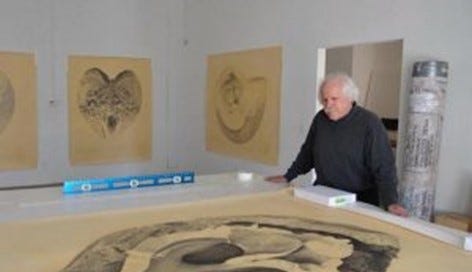Through December 22nd, at the Wright Contemporary in Taos, NM, we have a show of works by Gendron Jensen and Christine Taylor Patten, two extraordinary artists who devoted their lives to drawing with the simplest of means—graphite on paper and crow-quill pen and ink. I featured Taylor Patten a number of times in reports from the site and she contributed an essay during the pandemic, but I haven’t yet written a biographical profile of her, as I did for Jensen in 2018, about a year before his death. In his honor (and of course to publicize the show), I republish it here.
With his full beard and flowing corona of snow-white hair, Gendron Jensen looked a little like a poet from another century. Sometimes he sounded like one, too. “Nature is dispassionately nurturing at its heart,” he at declared at one point during an interview. “I can reach out with my long arms and visually take it into my keeping.”
For the bulk of his five-decade career, Jensen focused exclusively on one of nature’s most evocative and yet easily overlooked relics: animal bones he found while hiking the north woods of Minnesota or the extensive lands near his adopted home outside Taos, NM. He worked almost exclusively in graphite on sheets of paper as tall as seven feet, making meticulous renderings of the intricate infrastructures of wildlife, some of them road kill he came across in his wanderings. The drawings are so precise zoologists can identify them by species, but disembodied from their source that have a spooky, iconic presence, like the totems of some unknown tribe.
Jensen discovered his first bones at the age of six, when he went exploring the hardwood forest in back of the family home. Wading in the reeds of a lake he found the skull of what was probably a red squirrel. “The upper teeth, the central incisors, curved back into the skull,” he recalled. “I was able to pull that crescent-like bone all the way out, and it touched me in a deep way.”
At the age of 19, the artist entered a monastery in southeastern Wisconsin but stopped short of taking his vows and enlisted in the navy. Following a nervous breakdown, he returned to the monastery and spent the next four years working in the print shop and living in the beekeeping house. When he was 26, he began drawing: “From the water to the land to the air, all of the creatures that roamed the wilderness in proximity to the abbey were at my disposal,” he said.
From 1970 to ’86, during what Jensen called his “burning years,” he continued to live in the north woods, doing odd jobs, hauling garbage, building houses, or working in the grocery store. “I did grunt work so that I could keep my mind free to unfurl,” he recalled. “I slowly began more and more to draw all the time.” He established his first “bone room” in the family farmhouse in Grand Rapids, MN, and kept shelf upon shelf of bones in the studio he called the “ossorium” in his home in Placita, NM.
In the late 1980s, Jensen met Christine Taylor Patten, an artist in Santa Fe whose meticulously crafted crow-quill drawings in ink were singled out for high praise at the Istanbul Biennial niney ears ago. Their courtship took place mostly via the mail, as they sent more than 100 letters back and forth, including pictures of works in progress. They were married in August of 1987.
Jensen had his first gallery show in Chicago in 1972 and slowly began to attract more attention with exhibitions in Albuquerque, Minneapolis, Washington, D.C., and Geneva. Throughout his career he was encouraged by mentors like feminist art historian Griselda Pollock and Graham W. J. Beal, director of the Detroit Institute of Arts, who was chief curator of the Walker Art Center in the late 1970s and was attracted to Jensen’s work for its “fierce spirituality.”
Spring of 2010 marked his first New York show at Knoedler Galleries. Three years later, filmmaker Kristian Berg directed and produced “Poustinia” (from a word meaning “spiritual grounding”) about Jensen’s life and work. The half-hour documentary vividly captures the artist’s process and deeply spiritual connection with his subjects (“When I find them,” he said of the bones, “I feel this tingling in my hands.”) The film also offers an affecting glimpse into the collaboration between an artist and printmaker—in Jensen’s case, Tamarind Press in Albuquerque NM, with whom he worked on producing numerous lithographs.
When I first interviewed him he was 78 and looked back on his early travails with a sense of equanimity. “At my age, I’ve been broken down by so much and sobered by so much,” he said, in typically elegiac language. “My winter of discontent has been a long one, but I’ve come into the bright morning, into this springful season.”








Beautiful.
This is a lovely, well written bio. It is rare to hear about an artist's spiritual life in a way that is tangible, as presented here. The drawings are exquisite...what a treat.